Waste and Pollution Management: Treatment and Minimization Methods
VerifiedAdded on 2023/06/12
|9
|1818
|344
Homework Assignment
AI Summary
This assignment focuses on waste and pollution management, specifically addressing wastewater treatment and waste minimization strategies. It begins by comparing the characteristics of fruit canning wastewater with domestic wastewater, highlighting differences in BOD5, COD, suspended solids, and pH levels, and suggests anaerobic digestion as an appropriate treatment system. The assignment then discusses various membrane and hybrid membrane systems used in drinking water treatment (to remove turbidity, bacteria, and viruses), wastewater treatment (to remove BOD5), and seawater or treated wastewater (to remove inorganic salts). Finally, it examines a beer factory's wastewater treatment process, explaining the use of solid contact clarifiers and activated carbon filters, proposing a waste minimization program, and calculating the COD of combined wastewater streams. Desklib provides this assignment solution and many other resources for students.
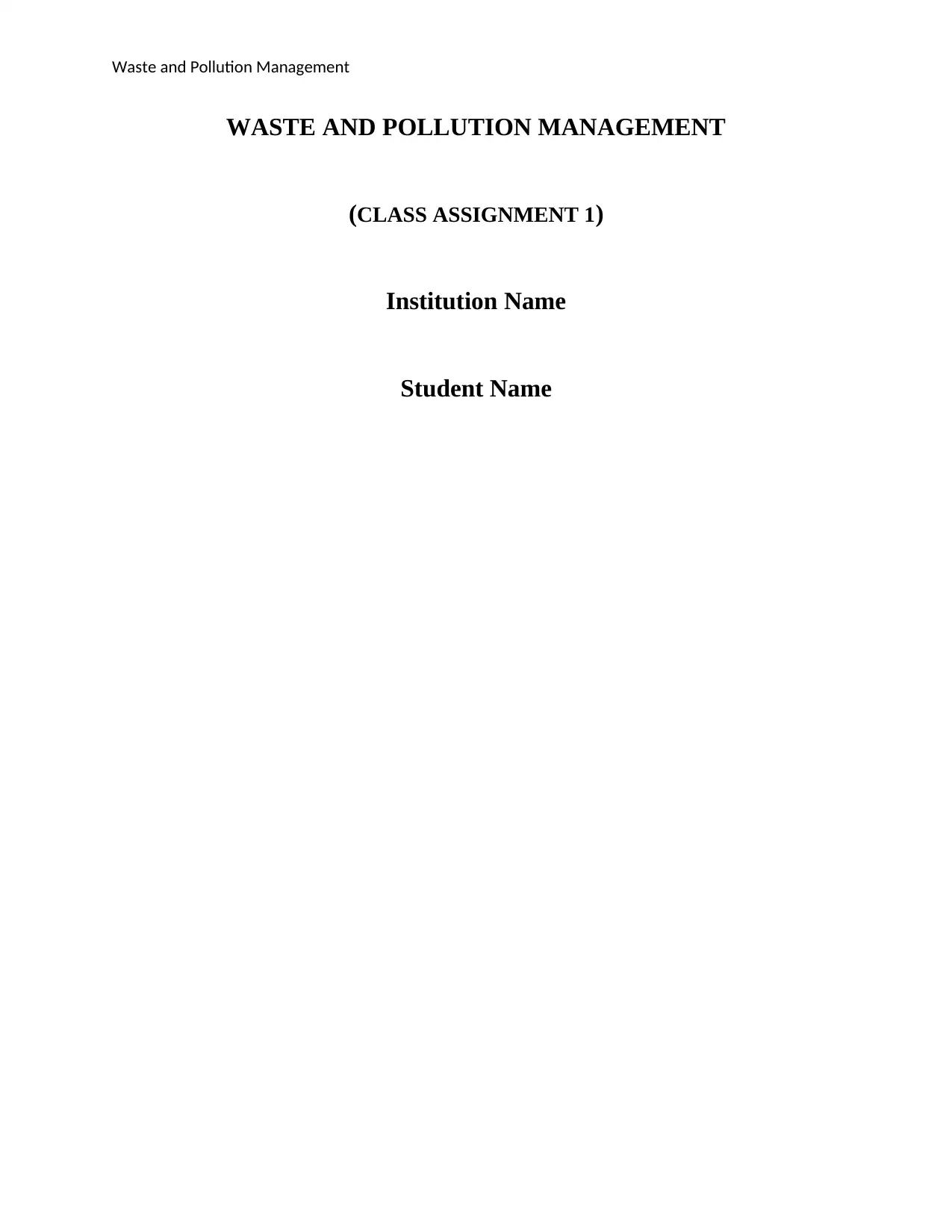
Waste and Pollution Management
WASTE AND POLLUTION MANAGEMENT
(CLASS ASSIGNMENT 1)
Institution Name
Student Name
WASTE AND POLLUTION MANAGEMENT
(CLASS ASSIGNMENT 1)
Institution Name
Student Name
Paraphrase This Document
Need a fresh take? Get an instant paraphrase of this document with our AI Paraphraser
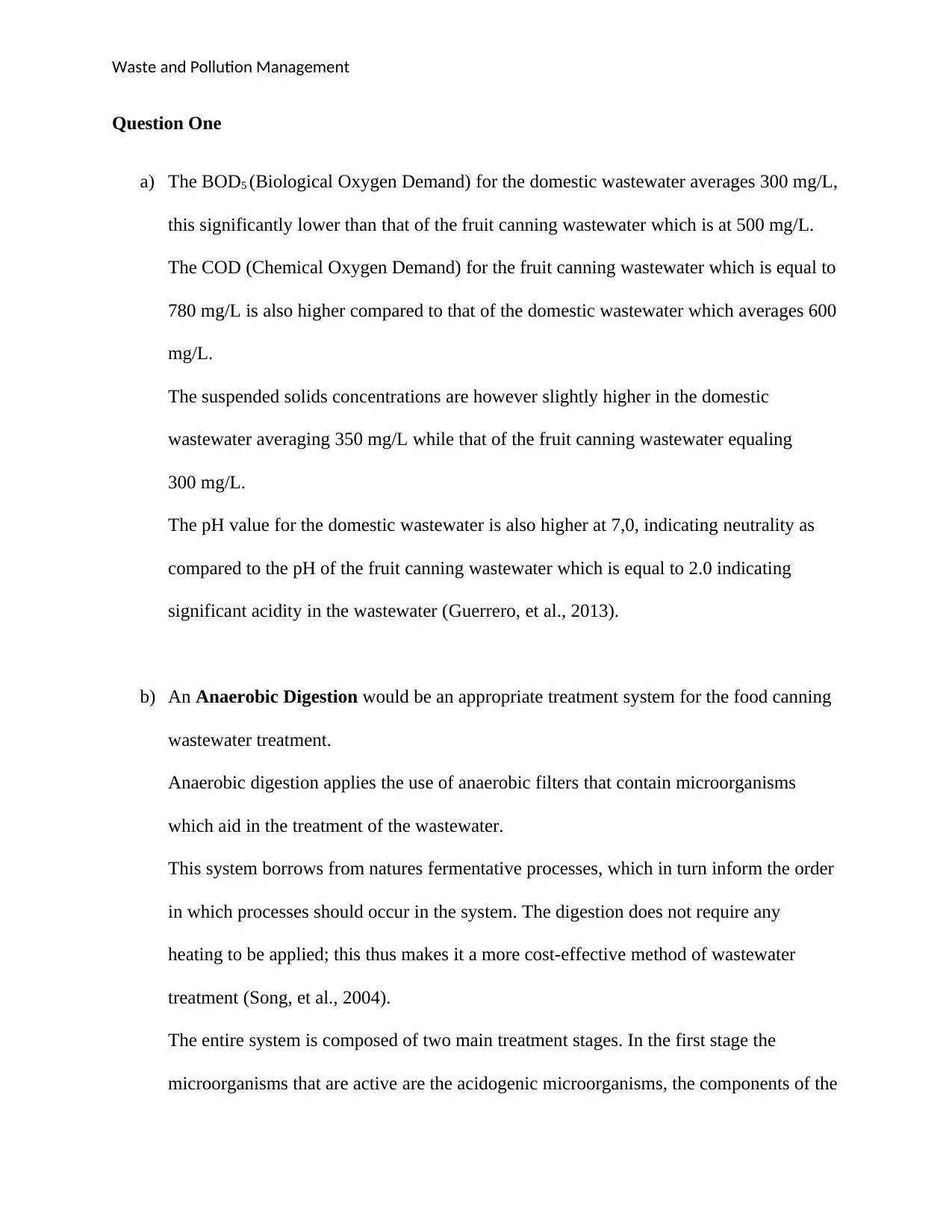
Waste and Pollution Management
Question One
a) The BOD5 (Biological Oxygen Demand) for the domestic wastewater averages 300 mg/L,
this significantly lower than that of the fruit canning wastewater which is at 500 mg/L.
The COD (Chemical Oxygen Demand) for the fruit canning wastewater which is equal to
780 mg/L is also higher compared to that of the domestic wastewater which averages 600
mg/L.
The suspended solids concentrations are however slightly higher in the domestic
wastewater averaging 350 mg/L while that of the fruit canning wastewater equaling
300 mg/L.
The pH value for the domestic wastewater is also higher at 7,0, indicating neutrality as
compared to the pH of the fruit canning wastewater which is equal to 2.0 indicating
significant acidity in the wastewater (Guerrero, et al., 2013).
b) An Anaerobic Digestion would be an appropriate treatment system for the food canning
wastewater treatment.
Anaerobic digestion applies the use of anaerobic filters that contain microorganisms
which aid in the treatment of the wastewater.
This system borrows from natures fermentative processes, which in turn inform the order
in which processes should occur in the system. The digestion does not require any
heating to be applied; this thus makes it a more cost-effective method of wastewater
treatment (Song, et al., 2004).
The entire system is composed of two main treatment stages. In the first stage the
microorganisms that are active are the acidogenic microorganisms, the components of the
Question One
a) The BOD5 (Biological Oxygen Demand) for the domestic wastewater averages 300 mg/L,
this significantly lower than that of the fruit canning wastewater which is at 500 mg/L.
The COD (Chemical Oxygen Demand) for the fruit canning wastewater which is equal to
780 mg/L is also higher compared to that of the domestic wastewater which averages 600
mg/L.
The suspended solids concentrations are however slightly higher in the domestic
wastewater averaging 350 mg/L while that of the fruit canning wastewater equaling
300 mg/L.
The pH value for the domestic wastewater is also higher at 7,0, indicating neutrality as
compared to the pH of the fruit canning wastewater which is equal to 2.0 indicating
significant acidity in the wastewater (Guerrero, et al., 2013).
b) An Anaerobic Digestion would be an appropriate treatment system for the food canning
wastewater treatment.
Anaerobic digestion applies the use of anaerobic filters that contain microorganisms
which aid in the treatment of the wastewater.
This system borrows from natures fermentative processes, which in turn inform the order
in which processes should occur in the system. The digestion does not require any
heating to be applied; this thus makes it a more cost-effective method of wastewater
treatment (Song, et al., 2004).
The entire system is composed of two main treatment stages. In the first stage the
microorganisms that are active are the acidogenic microorganisms, the components of the
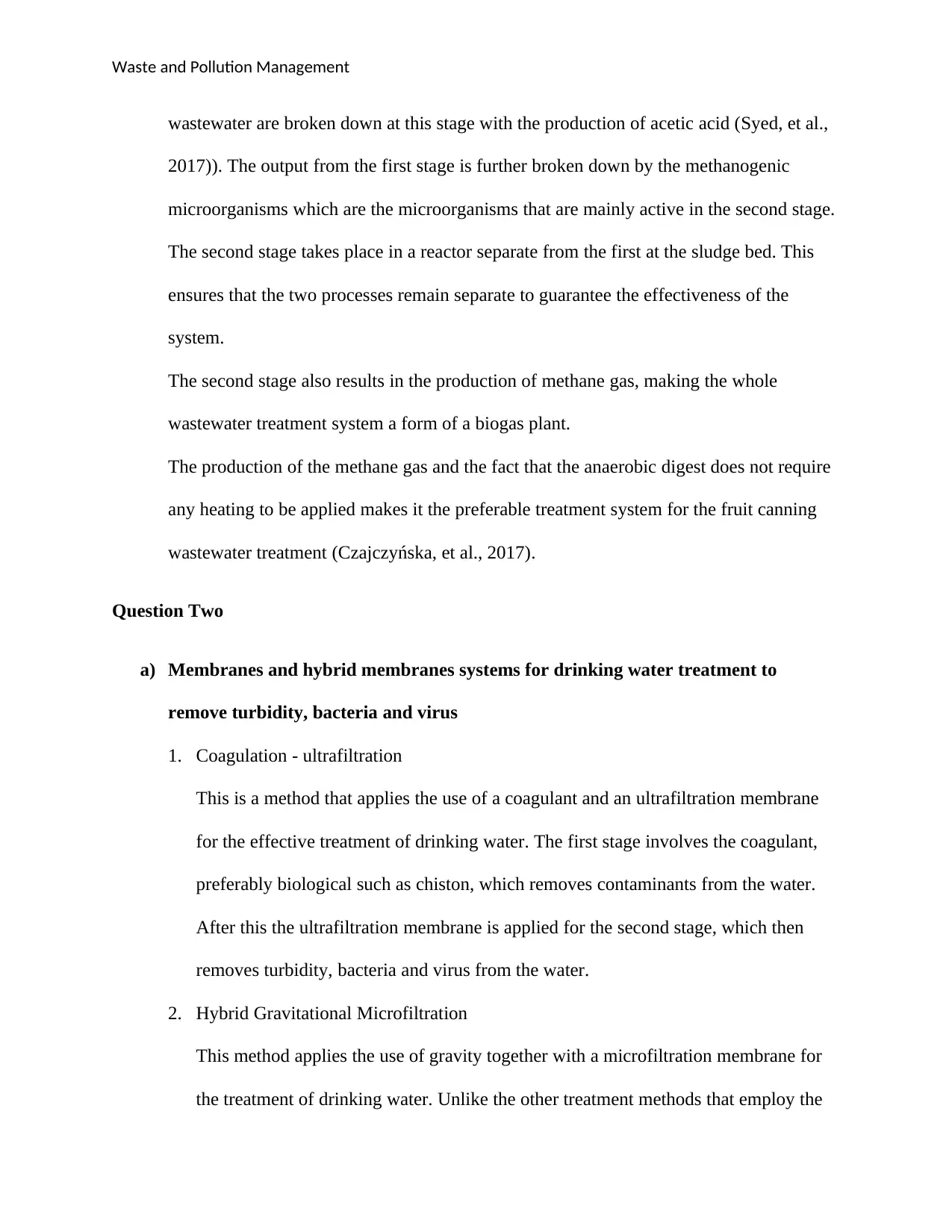
Waste and Pollution Management
wastewater are broken down at this stage with the production of acetic acid (Syed, et al.,
2017)). The output from the first stage is further broken down by the methanogenic
microorganisms which are the microorganisms that are mainly active in the second stage.
The second stage takes place in a reactor separate from the first at the sludge bed. This
ensures that the two processes remain separate to guarantee the effectiveness of the
system.
The second stage also results in the production of methane gas, making the whole
wastewater treatment system a form of a biogas plant.
The production of the methane gas and the fact that the anaerobic digest does not require
any heating to be applied makes it the preferable treatment system for the fruit canning
wastewater treatment (Czajczyńska, et al., 2017).
Question Two
a) Membranes and hybrid membranes systems for drinking water treatment to
remove turbidity, bacteria and virus
1. Coagulation - ultrafiltration
This is a method that applies the use of a coagulant and an ultrafiltration membrane
for the effective treatment of drinking water. The first stage involves the coagulant,
preferably biological such as chiston, which removes contaminants from the water.
After this the ultrafiltration membrane is applied for the second stage, which then
removes turbidity, bacteria and virus from the water.
2. Hybrid Gravitational Microfiltration
This method applies the use of gravity together with a microfiltration membrane for
the treatment of drinking water. Unlike the other treatment methods that employ the
wastewater are broken down at this stage with the production of acetic acid (Syed, et al.,
2017)). The output from the first stage is further broken down by the methanogenic
microorganisms which are the microorganisms that are mainly active in the second stage.
The second stage takes place in a reactor separate from the first at the sludge bed. This
ensures that the two processes remain separate to guarantee the effectiveness of the
system.
The second stage also results in the production of methane gas, making the whole
wastewater treatment system a form of a biogas plant.
The production of the methane gas and the fact that the anaerobic digest does not require
any heating to be applied makes it the preferable treatment system for the fruit canning
wastewater treatment (Czajczyńska, et al., 2017).
Question Two
a) Membranes and hybrid membranes systems for drinking water treatment to
remove turbidity, bacteria and virus
1. Coagulation - ultrafiltration
This is a method that applies the use of a coagulant and an ultrafiltration membrane
for the effective treatment of drinking water. The first stage involves the coagulant,
preferably biological such as chiston, which removes contaminants from the water.
After this the ultrafiltration membrane is applied for the second stage, which then
removes turbidity, bacteria and virus from the water.
2. Hybrid Gravitational Microfiltration
This method applies the use of gravity together with a microfiltration membrane for
the treatment of drinking water. Unlike the other treatment methods that employ the
⊘ This is a preview!⊘
Do you want full access?
Subscribe today to unlock all pages.

Trusted by 1+ million students worldwide
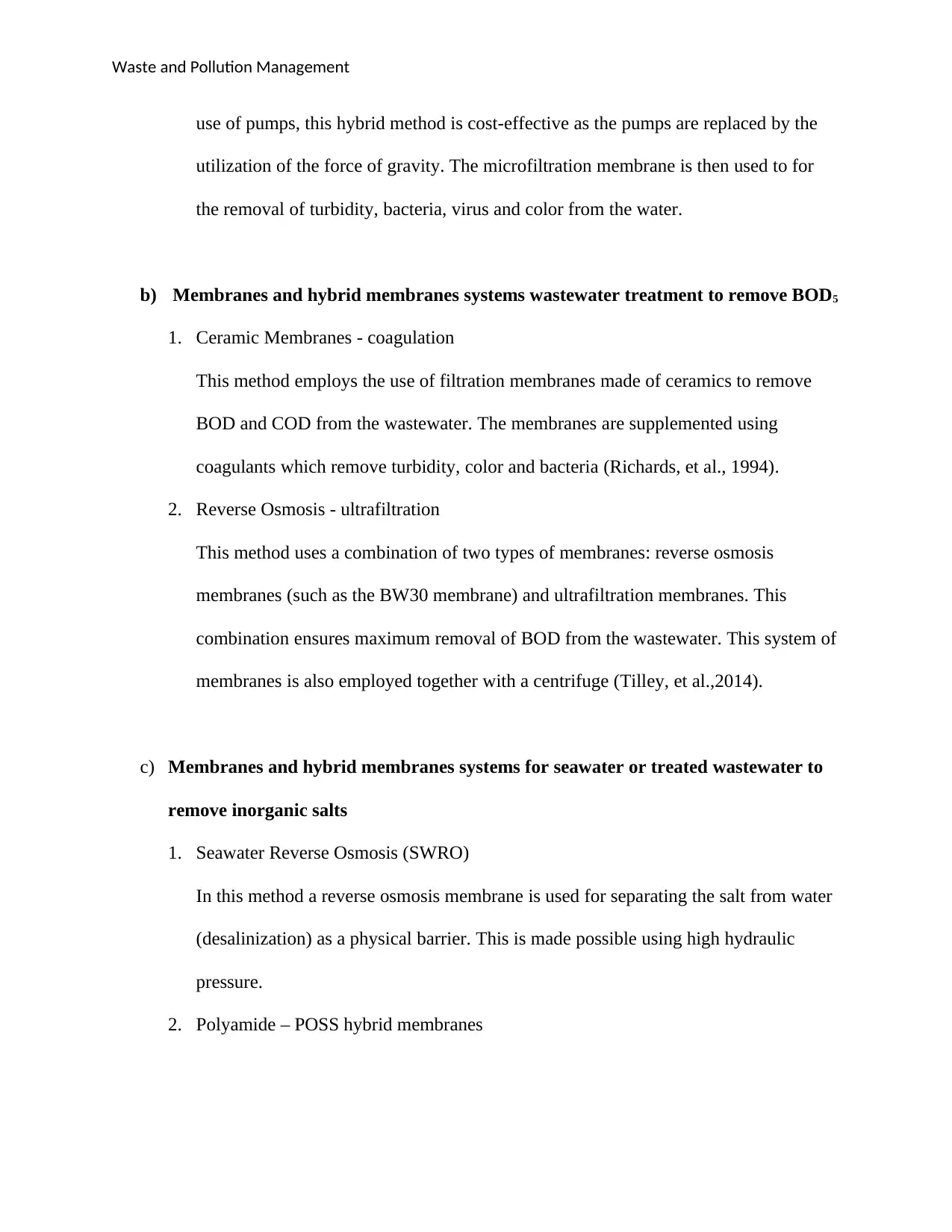
Waste and Pollution Management
use of pumps, this hybrid method is cost-effective as the pumps are replaced by the
utilization of the force of gravity. The microfiltration membrane is then used to for
the removal of turbidity, bacteria, virus and color from the water.
b) Membranes and hybrid membranes systems wastewater treatment to remove BOD5
1. Ceramic Membranes - coagulation
This method employs the use of filtration membranes made of ceramics to remove
BOD and COD from the wastewater. The membranes are supplemented using
coagulants which remove turbidity, color and bacteria (Richards, et al., 1994).
2. Reverse Osmosis - ultrafiltration
This method uses a combination of two types of membranes: reverse osmosis
membranes (such as the BW30 membrane) and ultrafiltration membranes. This
combination ensures maximum removal of BOD from the wastewater. This system of
membranes is also employed together with a centrifuge (Tilley, et al.,2014).
c) Membranes and hybrid membranes systems for seawater or treated wastewater to
remove inorganic salts
1. Seawater Reverse Osmosis (SWRO)
In this method a reverse osmosis membrane is used for separating the salt from water
(desalinization) as a physical barrier. This is made possible using high hydraulic
pressure.
2. Polyamide – POSS hybrid membranes
use of pumps, this hybrid method is cost-effective as the pumps are replaced by the
utilization of the force of gravity. The microfiltration membrane is then used to for
the removal of turbidity, bacteria, virus and color from the water.
b) Membranes and hybrid membranes systems wastewater treatment to remove BOD5
1. Ceramic Membranes - coagulation
This method employs the use of filtration membranes made of ceramics to remove
BOD and COD from the wastewater. The membranes are supplemented using
coagulants which remove turbidity, color and bacteria (Richards, et al., 1994).
2. Reverse Osmosis - ultrafiltration
This method uses a combination of two types of membranes: reverse osmosis
membranes (such as the BW30 membrane) and ultrafiltration membranes. This
combination ensures maximum removal of BOD from the wastewater. This system of
membranes is also employed together with a centrifuge (Tilley, et al.,2014).
c) Membranes and hybrid membranes systems for seawater or treated wastewater to
remove inorganic salts
1. Seawater Reverse Osmosis (SWRO)
In this method a reverse osmosis membrane is used for separating the salt from water
(desalinization) as a physical barrier. This is made possible using high hydraulic
pressure.
2. Polyamide – POSS hybrid membranes
Paraphrase This Document
Need a fresh take? Get an instant paraphrase of this document with our AI Paraphraser
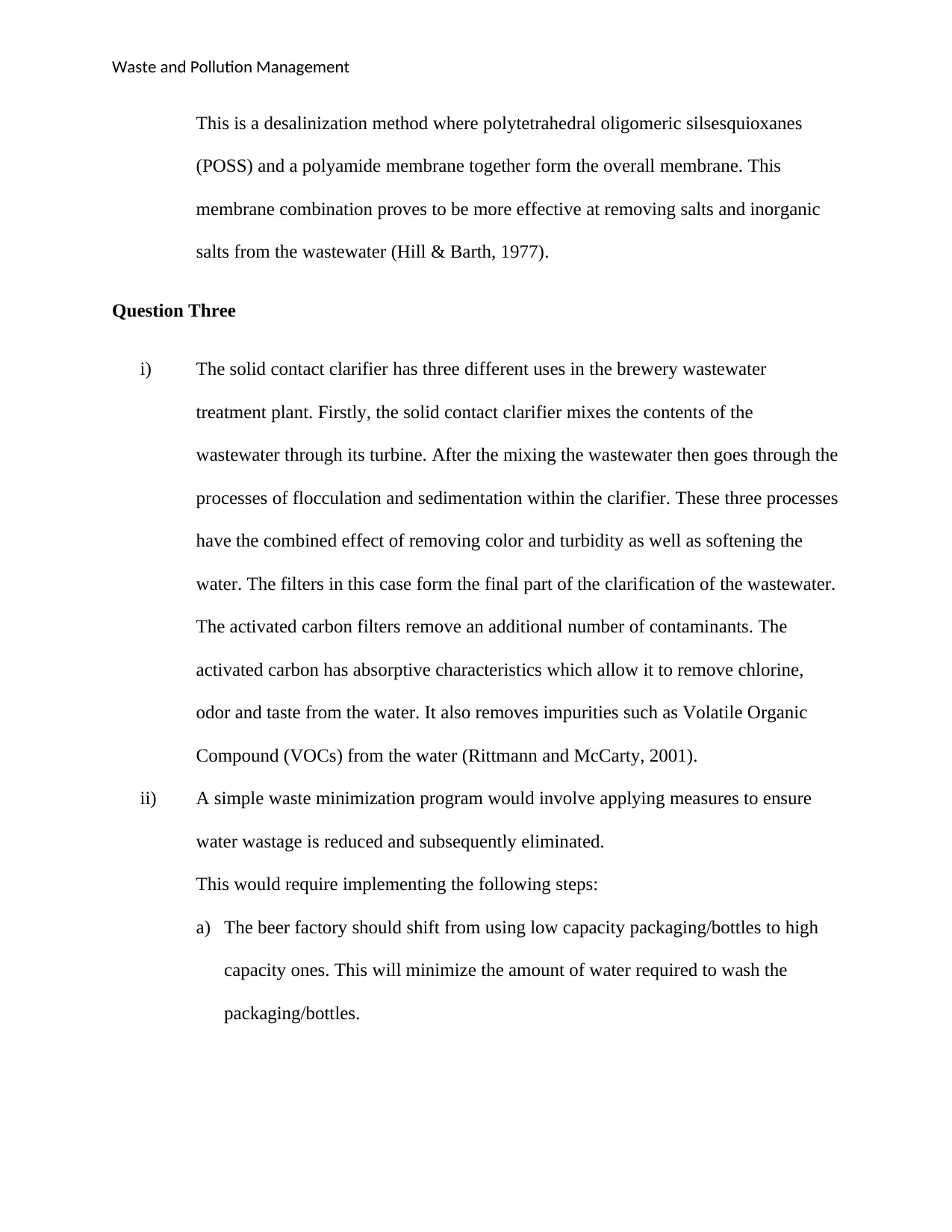
Waste and Pollution Management
This is a desalinization method where polytetrahedral oligomeric silsesquioxanes
(POSS) and a polyamide membrane together form the overall membrane. This
membrane combination proves to be more effective at removing salts and inorganic
salts from the wastewater (Hill & Barth, 1977).
Question Three
i) The solid contact clarifier has three different uses in the brewery wastewater
treatment plant. Firstly, the solid contact clarifier mixes the contents of the
wastewater through its turbine. After the mixing the wastewater then goes through the
processes of flocculation and sedimentation within the clarifier. These three processes
have the combined effect of removing color and turbidity as well as softening the
water. The filters in this case form the final part of the clarification of the wastewater.
The activated carbon filters remove an additional number of contaminants. The
activated carbon has absorptive characteristics which allow it to remove chlorine,
odor and taste from the water. It also removes impurities such as Volatile Organic
Compound (VOCs) from the water (Rittmann and McCarty, 2001).
ii) A simple waste minimization program would involve applying measures to ensure
water wastage is reduced and subsequently eliminated.
This would require implementing the following steps:
a) The beer factory should shift from using low capacity packaging/bottles to high
capacity ones. This will minimize the amount of water required to wash the
packaging/bottles.
This is a desalinization method where polytetrahedral oligomeric silsesquioxanes
(POSS) and a polyamide membrane together form the overall membrane. This
membrane combination proves to be more effective at removing salts and inorganic
salts from the wastewater (Hill & Barth, 1977).
Question Three
i) The solid contact clarifier has three different uses in the brewery wastewater
treatment plant. Firstly, the solid contact clarifier mixes the contents of the
wastewater through its turbine. After the mixing the wastewater then goes through the
processes of flocculation and sedimentation within the clarifier. These three processes
have the combined effect of removing color and turbidity as well as softening the
water. The filters in this case form the final part of the clarification of the wastewater.
The activated carbon filters remove an additional number of contaminants. The
activated carbon has absorptive characteristics which allow it to remove chlorine,
odor and taste from the water. It also removes impurities such as Volatile Organic
Compound (VOCs) from the water (Rittmann and McCarty, 2001).
ii) A simple waste minimization program would involve applying measures to ensure
water wastage is reduced and subsequently eliminated.
This would require implementing the following steps:
a) The beer factory should shift from using low capacity packaging/bottles to high
capacity ones. This will minimize the amount of water required to wash the
packaging/bottles.
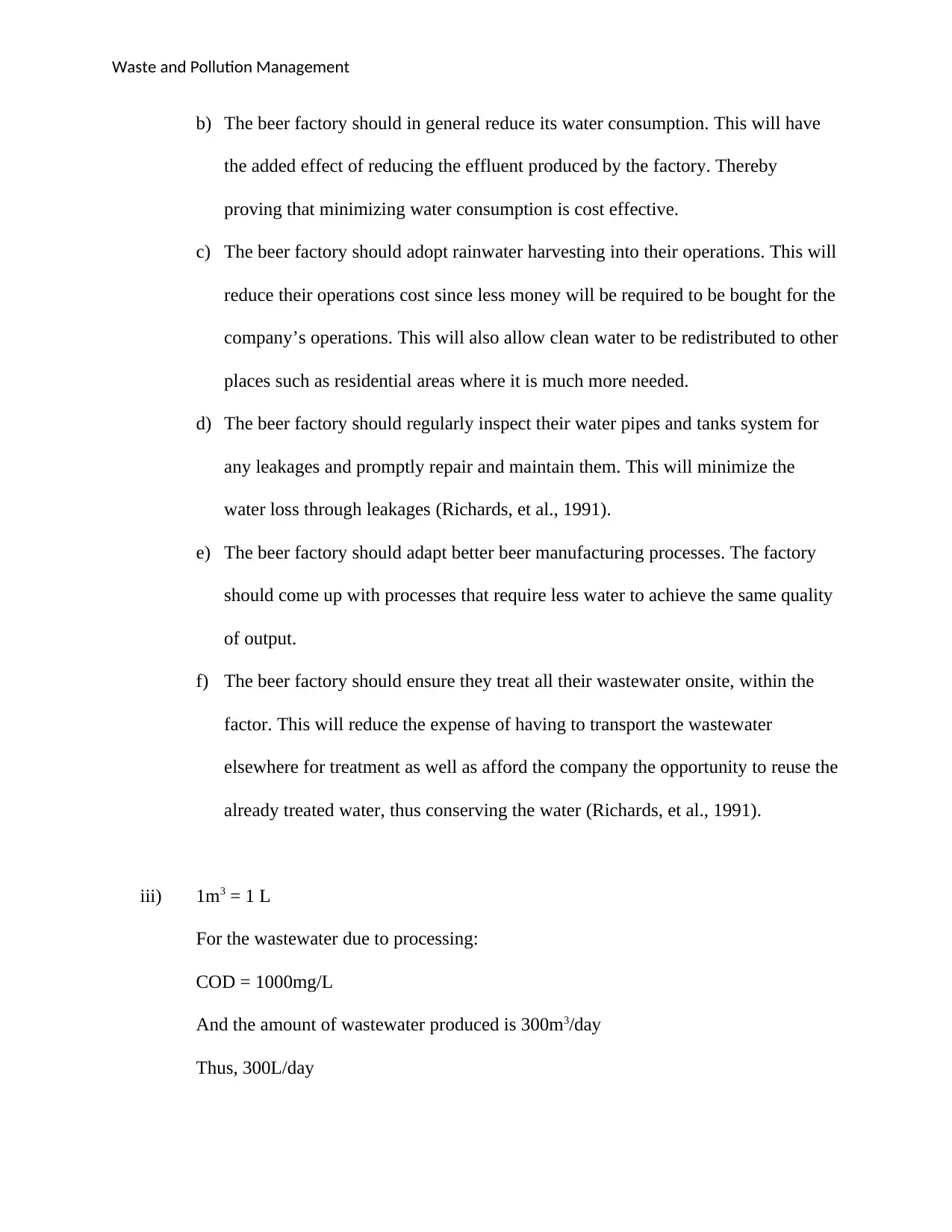
Waste and Pollution Management
b) The beer factory should in general reduce its water consumption. This will have
the added effect of reducing the effluent produced by the factory. Thereby
proving that minimizing water consumption is cost effective.
c) The beer factory should adopt rainwater harvesting into their operations. This will
reduce their operations cost since less money will be required to be bought for the
company’s operations. This will also allow clean water to be redistributed to other
places such as residential areas where it is much more needed.
d) The beer factory should regularly inspect their water pipes and tanks system for
any leakages and promptly repair and maintain them. This will minimize the
water loss through leakages (Richards, et al., 1991).
e) The beer factory should adapt better beer manufacturing processes. The factory
should come up with processes that require less water to achieve the same quality
of output.
f) The beer factory should ensure they treat all their wastewater onsite, within the
factor. This will reduce the expense of having to transport the wastewater
elsewhere for treatment as well as afford the company the opportunity to reuse the
already treated water, thus conserving the water (Richards, et al., 1991).
iii) 1m3 = 1 L
For the wastewater due to processing:
COD = 1000mg/L
And the amount of wastewater produced is 300m3/day
Thus, 300L/day
b) The beer factory should in general reduce its water consumption. This will have
the added effect of reducing the effluent produced by the factory. Thereby
proving that minimizing water consumption is cost effective.
c) The beer factory should adopt rainwater harvesting into their operations. This will
reduce their operations cost since less money will be required to be bought for the
company’s operations. This will also allow clean water to be redistributed to other
places such as residential areas where it is much more needed.
d) The beer factory should regularly inspect their water pipes and tanks system for
any leakages and promptly repair and maintain them. This will minimize the
water loss through leakages (Richards, et al., 1991).
e) The beer factory should adapt better beer manufacturing processes. The factory
should come up with processes that require less water to achieve the same quality
of output.
f) The beer factory should ensure they treat all their wastewater onsite, within the
factor. This will reduce the expense of having to transport the wastewater
elsewhere for treatment as well as afford the company the opportunity to reuse the
already treated water, thus conserving the water (Richards, et al., 1991).
iii) 1m3 = 1 L
For the wastewater due to processing:
COD = 1000mg/L
And the amount of wastewater produced is 300m3/day
Thus, 300L/day
⊘ This is a preview!⊘
Do you want full access?
Subscribe today to unlock all pages.

Trusted by 1+ million students worldwide
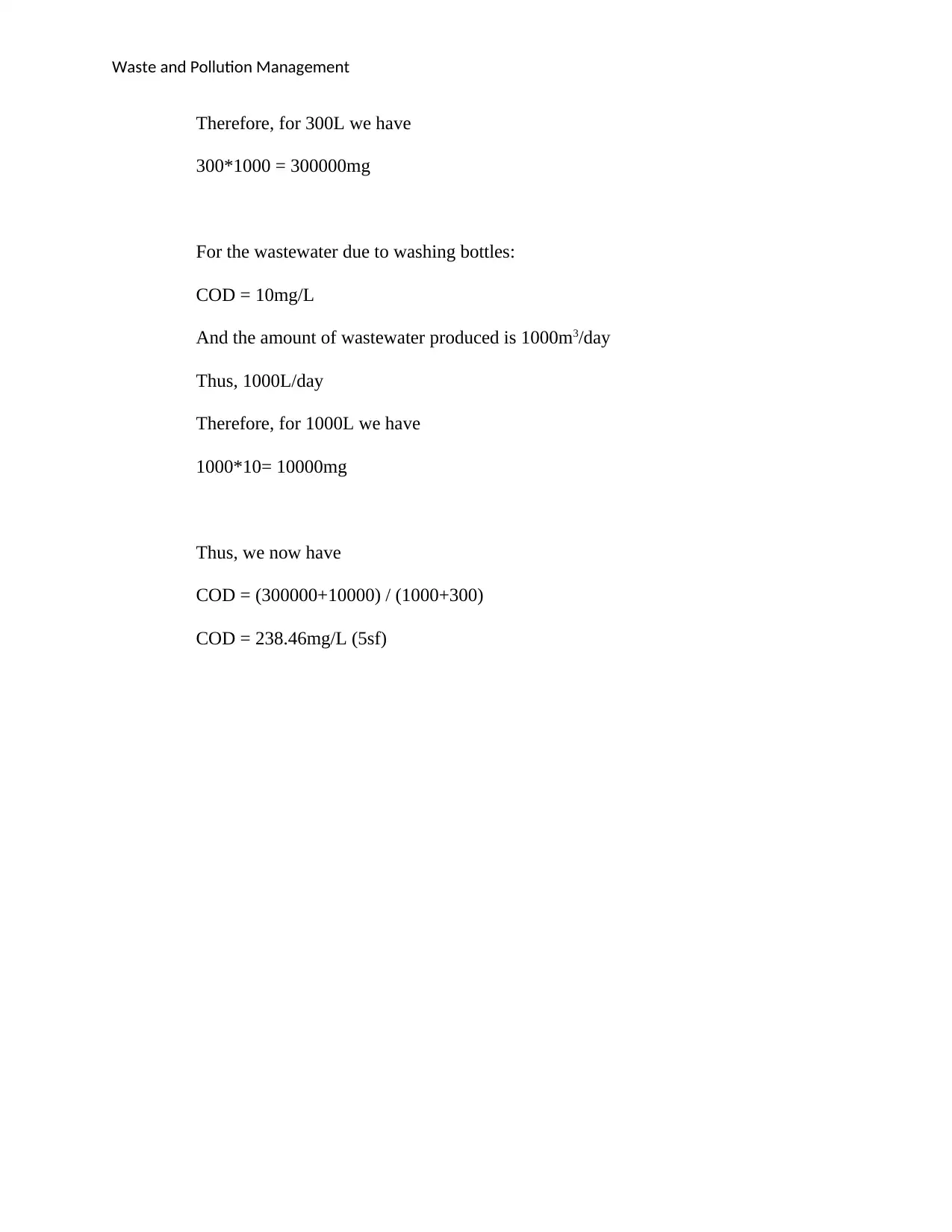
Waste and Pollution Management
Therefore, for 300L we have
300*1000 = 300000mg
For the wastewater due to washing bottles:
COD = 10mg/L
And the amount of wastewater produced is 1000m3/day
Thus, 1000L/day
Therefore, for 1000L we have
1000*10= 10000mg
Thus, we now have
COD = (300000+10000) / (1000+300)
COD = 238.46mg/L (5sf)
Therefore, for 300L we have
300*1000 = 300000mg
For the wastewater due to washing bottles:
COD = 10mg/L
And the amount of wastewater produced is 1000m3/day
Thus, 1000L/day
Therefore, for 1000L we have
1000*10= 10000mg
Thus, we now have
COD = (300000+10000) / (1000+300)
COD = 238.46mg/L (5sf)
Paraphrase This Document
Need a fresh take? Get an instant paraphrase of this document with our AI Paraphraser
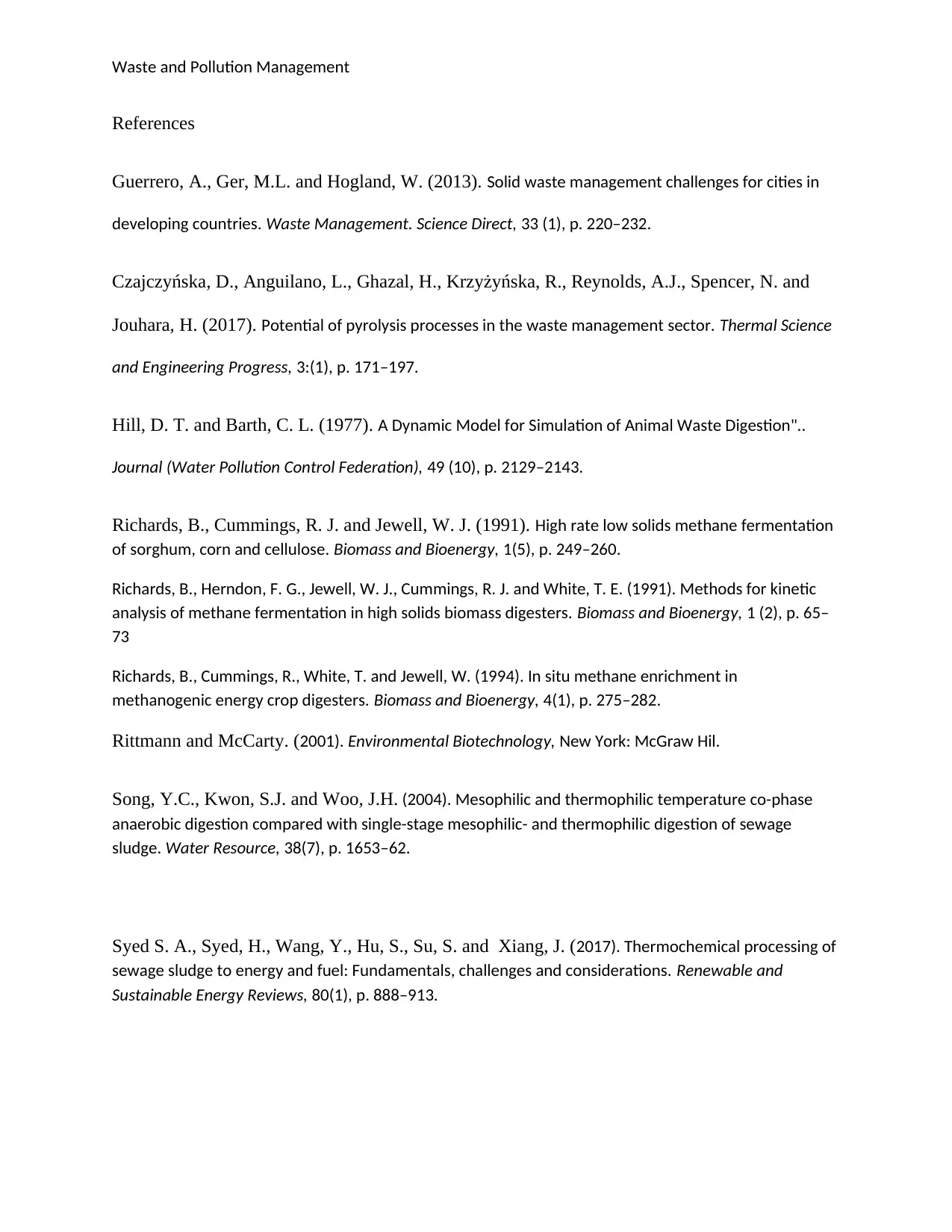
Waste and Pollution Management
References
Guerrero, A., Ger, M.L. and Hogland, W. (2013). Solid waste management challenges for cities in
developing countries. Waste Management. Science Direct, 33 (1), p. 220–232.
Czajczyńska, D., Anguilano, L., Ghazal, H., Krzyżyńska, R., Reynolds, A.J., Spencer, N. and
Jouhara, H. (2017). Potential of pyrolysis processes in the waste management sector. Thermal Science
and Engineering Progress, 3:(1), p. 171–197.
Hill, D. T. and Barth, C. L. (1977). A Dynamic Model for Simulation of Animal Waste Digestion"..
Journal (Water Pollution Control Federation), 49 (10), p. 2129–2143.
Richards, B., Cummings, R. J. and Jewell, W. J. (1991). High rate low solids methane fermentation
of sorghum, corn and cellulose. Biomass and Bioenergy, 1(5), p. 249–260.
Richards, B., Herndon, F. G., Jewell, W. J., Cummings, R. J. and White, T. E. (1991). Methods for kinetic
analysis of methane fermentation in high solids biomass digesters. Biomass and Bioenergy, 1 (2), p. 65–
73
Richards, B., Cummings, R., White, T. and Jewell, W. (1994). In situ methane enrichment in
methanogenic energy crop digesters. Biomass and Bioenergy, 4(1), p. 275–282.
Rittmann and McCarty. (2001). Environmental Biotechnology, New York: McGraw Hil.
Song, Y.C., Kwon, S.J. and Woo, J.H. (2004). Mesophilic and thermophilic temperature co-phase
anaerobic digestion compared with single-stage mesophilic- and thermophilic digestion of sewage
sludge. Water Resource, 38(7), p. 1653–62.
Syed S. A., Syed, H., Wang, Y., Hu, S., Su, S. and Xiang, J. (2017). Thermochemical processing of
sewage sludge to energy and fuel: Fundamentals, challenges and considerations. Renewable and
Sustainable Energy Reviews, 80(1), p. 888–913.
References
Guerrero, A., Ger, M.L. and Hogland, W. (2013). Solid waste management challenges for cities in
developing countries. Waste Management. Science Direct, 33 (1), p. 220–232.
Czajczyńska, D., Anguilano, L., Ghazal, H., Krzyżyńska, R., Reynolds, A.J., Spencer, N. and
Jouhara, H. (2017). Potential of pyrolysis processes in the waste management sector. Thermal Science
and Engineering Progress, 3:(1), p. 171–197.
Hill, D. T. and Barth, C. L. (1977). A Dynamic Model for Simulation of Animal Waste Digestion"..
Journal (Water Pollution Control Federation), 49 (10), p. 2129–2143.
Richards, B., Cummings, R. J. and Jewell, W. J. (1991). High rate low solids methane fermentation
of sorghum, corn and cellulose. Biomass and Bioenergy, 1(5), p. 249–260.
Richards, B., Herndon, F. G., Jewell, W. J., Cummings, R. J. and White, T. E. (1991). Methods for kinetic
analysis of methane fermentation in high solids biomass digesters. Biomass and Bioenergy, 1 (2), p. 65–
73
Richards, B., Cummings, R., White, T. and Jewell, W. (1994). In situ methane enrichment in
methanogenic energy crop digesters. Biomass and Bioenergy, 4(1), p. 275–282.
Rittmann and McCarty. (2001). Environmental Biotechnology, New York: McGraw Hil.
Song, Y.C., Kwon, S.J. and Woo, J.H. (2004). Mesophilic and thermophilic temperature co-phase
anaerobic digestion compared with single-stage mesophilic- and thermophilic digestion of sewage
sludge. Water Resource, 38(7), p. 1653–62.
Syed S. A., Syed, H., Wang, Y., Hu, S., Su, S. and Xiang, J. (2017). Thermochemical processing of
sewage sludge to energy and fuel: Fundamentals, challenges and considerations. Renewable and
Sustainable Energy Reviews, 80(1), p. 888–913.

Waste and Pollution Management
Tilley, E., Ulrich, L., Lüthi, C., Reymond, P. and Zurbrügg, C. (2014). Compendium of Sanitation
Systems and Technologies. 2nd Revised ed. Duebendorf, Switzerland: Swiss Federal Institute of Aquatic
Science and Technology.
Tilley, E., Ulrich, L., Lüthi, C., Reymond, P. and Zurbrügg, C. (2014). Compendium of Sanitation
Systems and Technologies. 2nd Revised ed. Duebendorf, Switzerland: Swiss Federal Institute of Aquatic
Science and Technology.
⊘ This is a preview!⊘
Do you want full access?
Subscribe today to unlock all pages.

Trusted by 1+ million students worldwide
1 out of 9
Your All-in-One AI-Powered Toolkit for Academic Success.
+13062052269
info@desklib.com
Available 24*7 on WhatsApp / Email
![[object Object]](/_next/static/media/star-bottom.7253800d.svg)
Unlock your academic potential
Copyright © 2020–2025 A2Z Services. All Rights Reserved. Developed and managed by ZUCOL.

